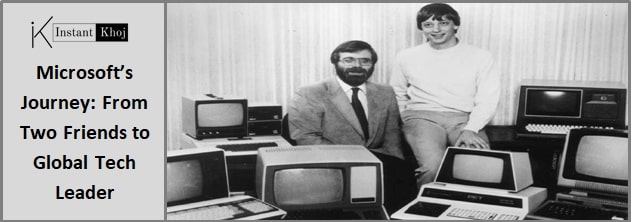A Simple Idea Sparks a Global Revolution
When people think of modern computing, Microsoft is often one of the first names that comes to mind. It’s a brand connected to billions of devices, from home computers to cloud servers. But long before becoming a global tech giant, Microsoft started with a simple idea shared between two childhood friends, Bill Gates and Paul Allen, who believed that computers would one day become personal and essential in everyday life.
From Hobby to History: The Birth of Microsoft
In the early 1970s, Gates and Allen were just teenagers in Seattle, obsessed with the idea of coding and computers. At a time when machines were large, expensive, and mostly used by governments or universities, they saw a future where individuals could use them too. That vision came into focus in 1975 when they discovered the Altair 8800, one of the first microcomputers. Though they had never used one, they quickly built a version of the BASIC programming language for it. Their successful demo led to a deal—and the birth of Microsoft.
A Software-First Strategy
What set Microsoft apart from the beginning was its focus on software. They weren’t building machines; they were building the brains behind them. In 1980, the company’s future changed dramatically when IBM, the industry leader in computing hardware, asked Microsoft to provide the operating system for its new personal computer. Microsoft didn’t yet have one, so they acquired a system called QDOS and adapted it into MS-DOS. The move was bold, but the real genius lay in the licensing agreement. Microsoft kept the rights to distribute the OS to other manufacturers, ensuring its software would run on millions of IBM-compatible machines. That decision made Microsoft the backbone of personal computing.
Enter Windows: A Visual Leap Forward
Although MS-DOS worked well for developers and advanced users, it wasn’t very friendly for everyday people. Microsoft realized the future was visual. Instead of typing commands, people would want to click icons and use a mouse. In 1985, Windows was born—a graphical interface that worked on top of MS-DOS. The first versions weren’t groundbreaking, but they laid the groundwork. By the early 90s, with Windows 3.0 and 3.1, the software improved dramatically, and adoption exploded in homes, schools, and offices around the world.
Transforming Work with Microsoft Office
At the same time, Microsoft introduced the Office suite, bundling together Word, Excel, and PowerPoint. These tools transformed business and education, allowing users to write, calculate, and present with ease. Office quickly became the standard for productivity, and for many, using a computer became synonymous with using Microsoft products.
Legal Challenges and Industry Pushback
But Microsoft’s rise to dominance also attracted criticism and legal trouble. In the late 1990s, the U.S. government filed an antitrust lawsuit, accusing the company of monopolistic practices, especially around bundling Internet Explorer with Windows. The case was widely publicized and could have broken the company apart, but Microsoft made changes and continued to thrive. This era also brought increased competition from companies like Netscape and, later, Google, forcing Microsoft to evolve.
Highs and Lows in a Changing Tech Landscape
In the 2000s, Microsoft faced both wins and losses. Windows XP, released in 2001, became one of its most beloved products, known for its reliability. But the company struggled to find similar success in the mobile and search markets, falling behind Apple and Google in key areas. Still, Microsoft kept investing heavily in the future—especially in cloud computing.
A New Era Under Satya Nadella
The company’s direction shifted dramatically in 2014 when Satya Nadella became CEO. Under his leadership, Microsoft transformed itself from a software-first company into a cloud-first one. Products like Office 365 moved to the cloud, and Microsoft Azure quickly became a top cloud platform for businesses and developers around the world. Nadella also embraced open-source technology and pushed for cross-platform support, softening Microsoft’s once rigid, Windows-only image.
Expanding into Gaming and AI
Beyond the cloud, Microsoft expanded into gaming and artificial intelligence. With its Xbox consoles and major studio acquisitions, the company set its sights on the future of entertainment. AI became another major focus, built into tools like Microsoft 365 and Azure services, making everything from work to creativity more intelligent and accessible.
Final Thoughts: A Legacy Still Unfolding
From two curious teens writing code to a multinational company shaping the future of computing, Microsoft’s journey has been marked by bold decisions, constant reinvention, and a clear belief in the power of software. Its ability to adapt to changing times and technologies suggests that, even decades later, Microsoft’s most transformative chapters may still be ahead.
Read more articles like this — Click here to explore now





2 thoughts on “Microsoft’s Journey: From Two Friends to Global Tech Leader”